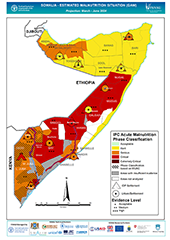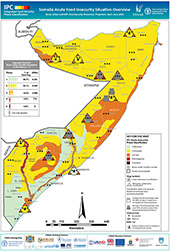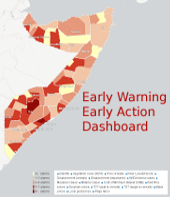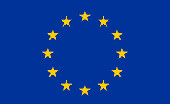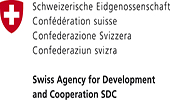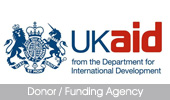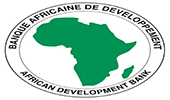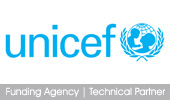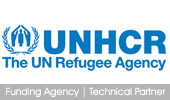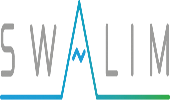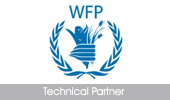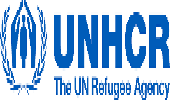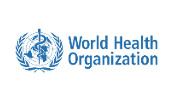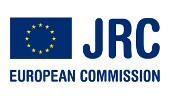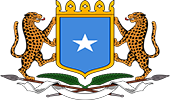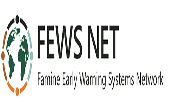FSNAU-FEWS NET Technical Release, August 31, 2015
Issued: August 31, 2015
Over 343,000 children in Somalia are at risk of acute malnutrition and 855,000 people face acute food insecurity
August 31, 2015, Nairobi/Washington – Widespread acute malnutrition persists across Somalia and large numbers of people will be acutely food insecure through December 2015, following below average cereal harvests in crop dependent areas; poor rainfall in some northern pastoral and agropastoral areas; trade disruption in some southern urban areas due to insurgent activities; and new and continued population displacement. This situation is likely to be exacerbated by heavier than normal expected rains and possible flooding in the October to December Deyr rainy season due to El Niño.
An estimated 214,700 children under the age of five are acutely malnourished (39,700 of them severely malnourished) based on prevalence results from 39 nutrition surveys conducted from May to July 2015 by the Food Security and Nutrition Analysis Unit for Somalia (FSNAU), a project managed by Food and Agriculture Organization (FAO) of the United Nations, and partners across Somalia. The number of acutely and severely malnourished children is likely to increase to 343,400 and 63,400, respectively, through the end of the year (incidence). The severely malnourished face a high risk of morbidity and death. Internally Displaced Persons (IDPs) in Dhobley currently face a nutrition emergency as the prevalence of Global Acute Malnutrition (GAM) has nearly doubled (from 11 percent in Deyr 2014/15 to 20.7 percent in Gu 2015) and is accompanied by Critical levels of Crude Death Rate-CDR (>1/10,000/day). IDPs in Dollow have had further deterioration in their nutrition situation since December 2014 with an increase in Critical levels of GAM (from 21.6 percent to 26.4 percent) along with an increase in both Crude Death Rates and Under-five Death Rates.
According to the latest findings from a joint countrywide seasonal assessment by FSNAU, the USAID-funded Famine Early Warning Systems Network (FEWS NET), and other partners, 855,000 people across Somalia will be in Crisis and Emergency (IPC Phases 3 and 4)[1] through December 2015. This figure represents an 17 percent increase over the estimate for February to June 2015. Internally displaced persons (IDPs) constitute 68 percent of the total number of people in Crisis and Emergency (IPC Phases 3 and 4), followed by rural (25 percent) and urban (7 percent) populations. Approximately 2.3 million additional people are classified as Stressed (IPC Phase 2) through December 2015.
Populations in Emergency and Crisis (IPC Phases 4 and 3) need urgent lifesaving humanitarian assistance and livelihood support, including urgent nutrition and health support for the acutely malnourished between now and December 2015. Populations experiencing acute food security Stressed (IPC Phase 2) remain highly vulnerable to shocks that could push them back to food security Crisis or Emergency (IPC Phases 3 or 4).
The 2015 Gu season (April-June) rains started on time but ended early, in May, in most regions. Mostly as a result of early cessation of the rains in the main cropping areas of southern Somalia, overall cereal production, including off-season production expected in September, was 25 percent below the long-term average (1995-2014). In the Northwest Agropastoral livelihood zone, poor rainfall contributed to low production prospects, with the 2015 Gu-Karan cereal harvest (October-November) estimated at only 37 percent of the five-year average for 2010-2014. In the nearby Guban Pastoral livelihood zone, drought conditions have contributed to a severe water shortage and unusual livestock deaths.
In most pastoral and agropastoral livelihood zones, livestock production and reproduction has continued to improve, contributing to improved food security outcomes. Further improvements are expected a result of better livestock performance in the forthcoming Deyr season.
El Niño is expected to bring much heavier rain than normal to central and southern Somalia from October to December, and flooding is very likely. This would have a negative impact on the food security of some riverine populations. Above average to average Deyr (October-December) rains are expected to lead to substantial improvement in food security conditions across most pastoral livelihood zones in central and southern Somalia. In northern pastoral areas, Deyr rains are expected to be below average to average, resulting in a moderate improvement in food security.
Areas and Populations of Concern
Populations in Crisis and Emergency (IPC Phases 3 and 4) are priorities for food security and livelihoods support programming.
They are found in large proportions (10 percent or more of total regional population) in the following regions: Banadir (42 percent), South Mudug (21 percent), Bari (21 percent), Awdal (13 percent), Lower Juba (13 percent), Woqooyi Galbeed (11 percent), and North Mudug (10 percent). Other priority groups include poor and vulnerable urban populations in the South that have been affected by trade disruption due to insurgent activities in Bulo Burto (Hiran Region) and Hudur and Wajid (Bakool Region).
As malnutrition rates are Critical[2], the following livelihood zones and population groups are priorities for nutrition programming:
· Pastoral, Agropastoral, and Riverine populations and Dollow IDPs in Gedo Region;
· Beletweyne and Mataban Districts in Hiran Region;
· Baidoa IDPs in Bay Region;
· Dhobley IDPs in Lower Juba Region;
· Garowe IDPs in Nugaal Region;
· Galkayo IDPs in Mudug Region; and
· Coastal Deeh Pastoral and Cowpea Belt Agropastoral livelihood zones of Mudug and Galgadud Regions.
In the drought-affected Guban Pastoral livelihood zone, acute food security Crisis (IPC Phase 3) will prevail. More livestock deaths are expected until the start of Deyr rains in October, which bring run-off water from the adjacent highlands and Hays rains which start in December in the livelihood itself.
[1] The Integrated Food Security Phase Classification (IPC) is a set of tools and procedures to classify the severity of food insecurity using an widely accepted five-phase scale. At the area level, it divides areas into the following phases: IPC Phase 1=Minimal; Phase 2=Stressed; Phase 3=Crisis; Phase 4=Emergency; and Phase 5=Famine.
[2] Nutrition Situation is considered as Critical if Global Acute Malnutrition (GAM) prevalence is 15percent or higher or if 10.7percent or more of children have Mid-Upper Arm Circumference (MUAC) below the 125 millimeters (mm) threshold.
